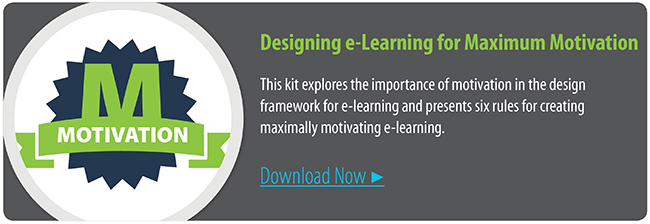Blog
We Need More Design In Instructional Design
by Richard Sites, vice president - training and marketing | @rhillsites Training efforts often begin with the need to change or improve the ...


Would Learners Pay for Your Training?
By Richard Sites | October 02, 2014 | Custom Learning | 0 Comments

by Richard Sites, vice president - training and marketing | @rhillsites

Training efforts often begin with the need to change or improve the performance of employees. However, this initial need can quickly fall to the wayside when the process of collecting information, designing instructional treatments, and seeking approval of the e-learning course begins.
This usually leads to the design and implementation of information-based e-learning rather than e-learning that is focused on the actual performance which needs improvement. Since information is easy to identify, collect, organize and present it provides learning and development teams with clear deliverables for managers and senior leaders to review and approve.
But taking the path of least resistance is not a productive route for the creation of performance-changing e-learning.
Why do we so often find ourselves designing e-learning to easily present information instead of challenging learners to perform better? I would suggest it is because our focus changes from the learner to the instructional product.
All too often our strategies for e-learning design are based on the need to build something within a timeframe, budget, and set of expectations—organizational expectations—in contrast to designing something targeting performance.
In Leaving ADDIE for SAM, Michael Allen describes three components of an instructional philosophy which is learner-based, rather than information based. You might have heard of the 3 M’s before—meaningful, memorable and motivational.
Learning events are meaningful when they place the learner in realistic places and situations where their performance occurs. Learning is memorable when learners are challenged to accomplish a task which provides genuine consequences for good and poor actions. Learning is motivational when learners can see the benefit the instruction can have on their performance and capability.
These guiding principles can help us keep our focus on the learners and move away from content-laden, information-based e-learning—which is not meaningful, memorable or motivational.
Just imagine if learning and development professionals would think of themselves as directors of marketing instead of designers of instructional products. Would they still focus so much energy on building products over empowering and motivating learners?
Very simply stated, the basic functions of a marketing department is to:
- Create awareness with your targeted customer
- Support the decision making process of your customer
- Lower the risk for your customer to take the next step
This sounds a lot like the 3 M’s doesn’t it? That’s because good marketing and good training both have the same goal—to create the situation where an individual can become more capable. Marketing looks to create the capability to purchase and training seeks to create the capability to perform their job.
So the next time you set out to design some e-learning, think of yourself in a marketing role and your job is to help the learners “purchase” your goods (that would be better performance).
I’d like to know what you think about marketing to your learners instead of just giving the information and hoping they make the purchase.

About the Author: Richard Sites
Comments
Would you like to leave a comment?
Related Blog Posts

By: Richard Sites | Jun, 2013
Category: Custom Learning, Strategic Consulting

Blog
You Asked. We Listened: Your Top e-Learning Design & Development Challenges
by Richard Sites, vice president - training and marketing | @rhillsites Training efforts often begin with the need to change or improve the ...
By: Richard Sites | Oct, 2015
Category: Custom Learning

Blog
Creating The Best e-Learning Design Ever!
by Richard Sites, vice president - training and marketing | @rhillsites Training efforts often begin with the need to change or improve the ...
By: Richard Sites | Feb, 2016
Category: Custom Learning


